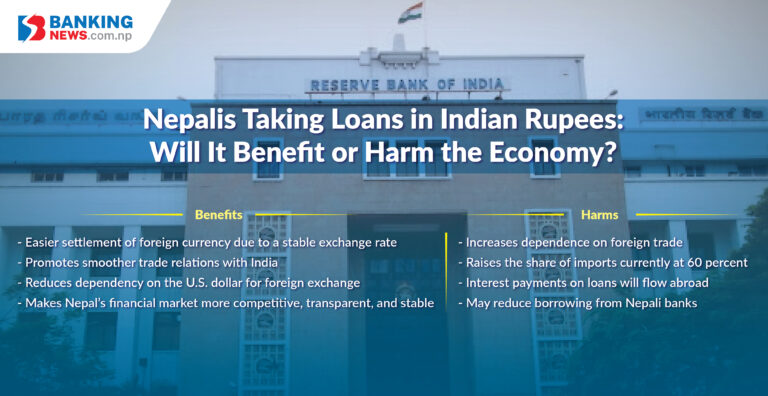India’s latest move to provide cross-border loans in Indian Rupees (INR) to neighboring countries including Nepal, Bhutan, and Sri Lanka has sparked widespread debate on whether it will strengthen or weaken Nepal’s economy.
Last week, the Reserve Bank of India (RBI) announced that authorized Indian banks will now be allowed to extend loans in rupees to businesses in these neighboring nations to facilitate cross-border trade. The move is part of India’s broader strategy to expand its regional trade influence in South Asia while reducing dependence on the U.S. dollar.
India’s Strategic Push for Regional Influence
As China strengthens its global trade footprint through the Belt and Road Initiative (BRI), India appears to be asserting its own economic presence in South Asia. Simultaneously, the U.S.’s increasingly protectionist trade policies and fluctuations in the dollar’s value have prompted India to strengthen the rupee’s role in international transactions.
Before this, India had already taken steps to fix exchange rates between the rupee and the UAE dirham as well as the Indonesian rupiah aiming to bypass the need to convert the rupee into dollars, pounds, euros, or yen for global trade.
The RBI has also expanded the use of Special Rupee Vostro Accounts accounts maintained by foreign banks to facilitate trade in rupees allowing the funds to be invested in corporate bonds and trade papers. In August, the RBI permitted such funds to be invested in central government securities, a move aimed at addressing issues India faced while purchasing oil from Russia in rupees.
The decision also reflects India’s growing concerns about the U.S. dollar being used as a geopolitical tool, especially after countries like Russia were excluded from the SWIFT payment system.
How Will It Impact Nepal?
Economists say the policy could have both advantages and drawbacks for Nepal.
Nepal conducts nearly 90% of its foreign trade with India, totaling about NRs 1.9 trillion annually. Therefore, a system allowing Indian rupee loans may have a significant impact on Nepal’s economy compared to Bhutan or Sri Lanka, where trade dependence on India is lower.
However, analysts told Banking News that the overall effect on regional trade dynamics will be minimal. According to the Financial Times, India’s initiative is unlikely to reshape trade strategies but could provoke reactions from global powers, particularly the United States.
Expert Opinions Divided
Trade expert Purushottam Ojha believes the move could increase Nepal’s dependency on India rather than benefit its economy.
“Around 80% of Nepal’s exports go to India, and 60–62% of imports come from India. Allowing Nepali businesses to borrow in rupees will only deepen this dependence,” he said. “Interest and principal repayments will further drain capital toward India.”
In contrast, Everest Bank CEO Sudesh Khaling views the RBI’s decision positively at least as long as the fixed exchange rate between the Nepali and Indian rupees remains intact.
“Nepal benefits as long as currency stability continues,” he said. “Avoiding double conversion between rupees and dollars can reduce transaction costs and promote trade efficiency.”
Possible Scenarios
If Indian banks start offering cheaper loans in rupees compared to Nepali banks, this could spark competition in Nepal’s financial market. For example, if Nepali banks charge 13% interest while Indian banks offer loans at 8%, Nepali businesses might opt for the cheaper Indian option pressuring local banks to lower rates.
This could eventually benefit consumers through more affordable loans and create price equilibrium in the long run. On the positive side, increased capital inflow from India could boost investment, industrial output, and job creation in Nepal.
However, this could also reduce the market share and profitability of Nepali banks, as demand for local loans may fall. Lower lending rates could force banks to reduce interest paid to depositors, discouraging savings and potentially causing liquidity stress in the domestic banking sector.
Small Businesses Could Gain Access
Experts also believe that small and medium enterprises (SMEs) may benefit from easier access to credit. Currently, only large traders have direct access to Indian financial systems. With this new provision, smaller Nepali businesses could obtain loans through authorized Indian banks, enhancing financial inclusion in cross-border trade.
Potential Risks and Uncertainties
A key concern, however, is the currency risk. Since most Nepali businesses earn in Nepali rupees, any appreciation in the Indian rupee’s value would increase repayment costs for borrowers.
While India’s policy allows lending to non-residents, its implementation details remain unclear, particularly regarding how such loans will be regulated across borders.
According to Kiran Pandit, spokesperson for Nepal Rastra Bank (NRB), Nepal’s central bank already allows borrowing in foreign currencies, including the Indian rupee.
“Nepalis can borrow in various foreign currencies under existing provisions,” Pandit told Banking News. “However, the NRB has yet to assess the potential impact of the RBI’s latest move on Nepal’s economy.”
A Step Toward Faster, Cheaper Trade
Analysts say the measure could simplify and speed up cross-border payments. Currently, most Nepal-India trade transactions are settled either through dollar conversions or manual currency exchanges between the Nepali and Indian rupees.
If implemented effectively, Indian rupee loans could reduce transaction time and costs, alleviate occasional rupee shortages in Nepal’s market, and ensure timely payments to Indian suppliers.
While the RBI’s initiative may strengthen trade efficiency and liquidity, it also raises crucial questions:
Will it empower Nepali businesses or tighten India’s grip on Nepal’s economy?
That, experts say, will depend on how both countries balance opportunity with independence in the years ahead.



 About Us
About Us
Comment